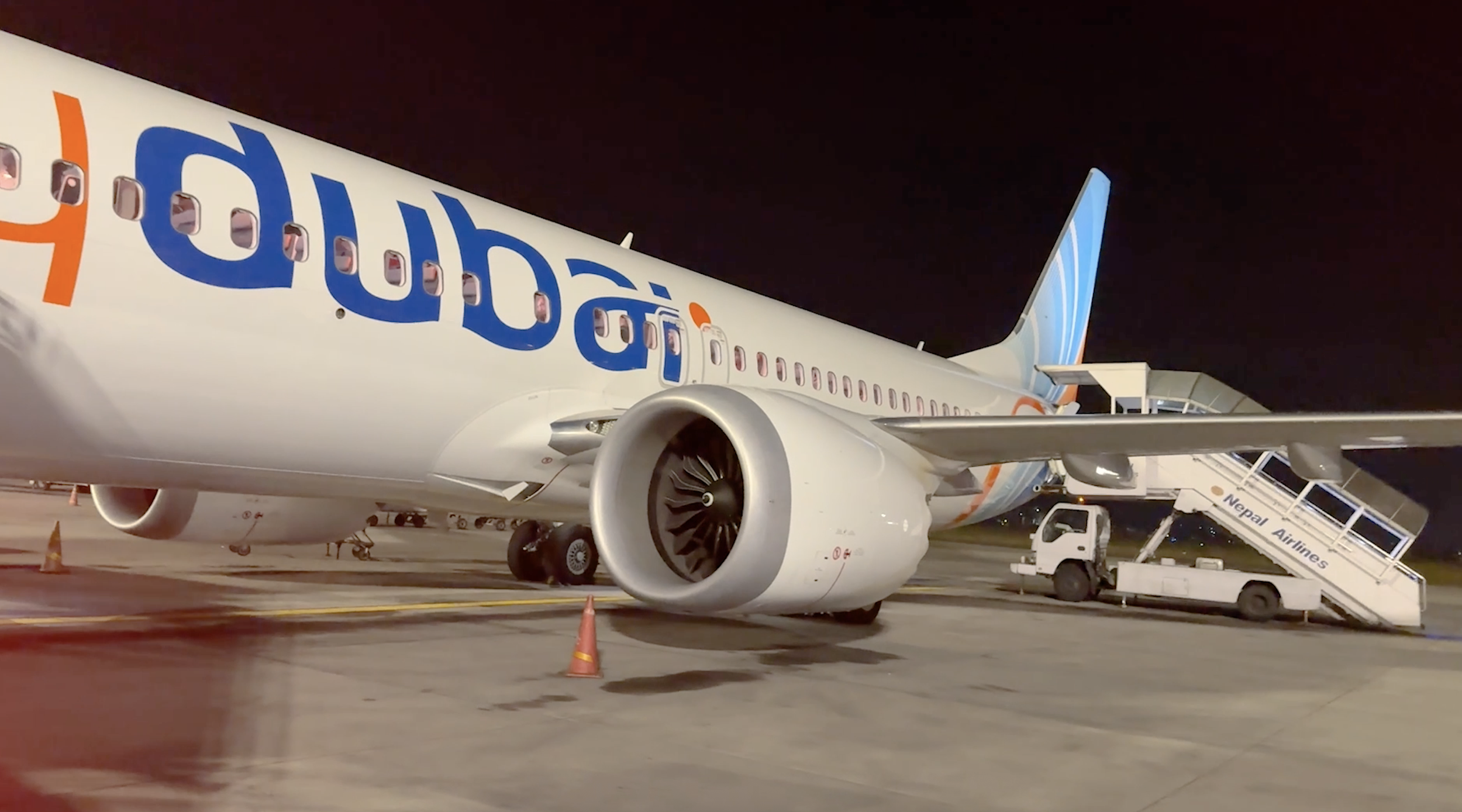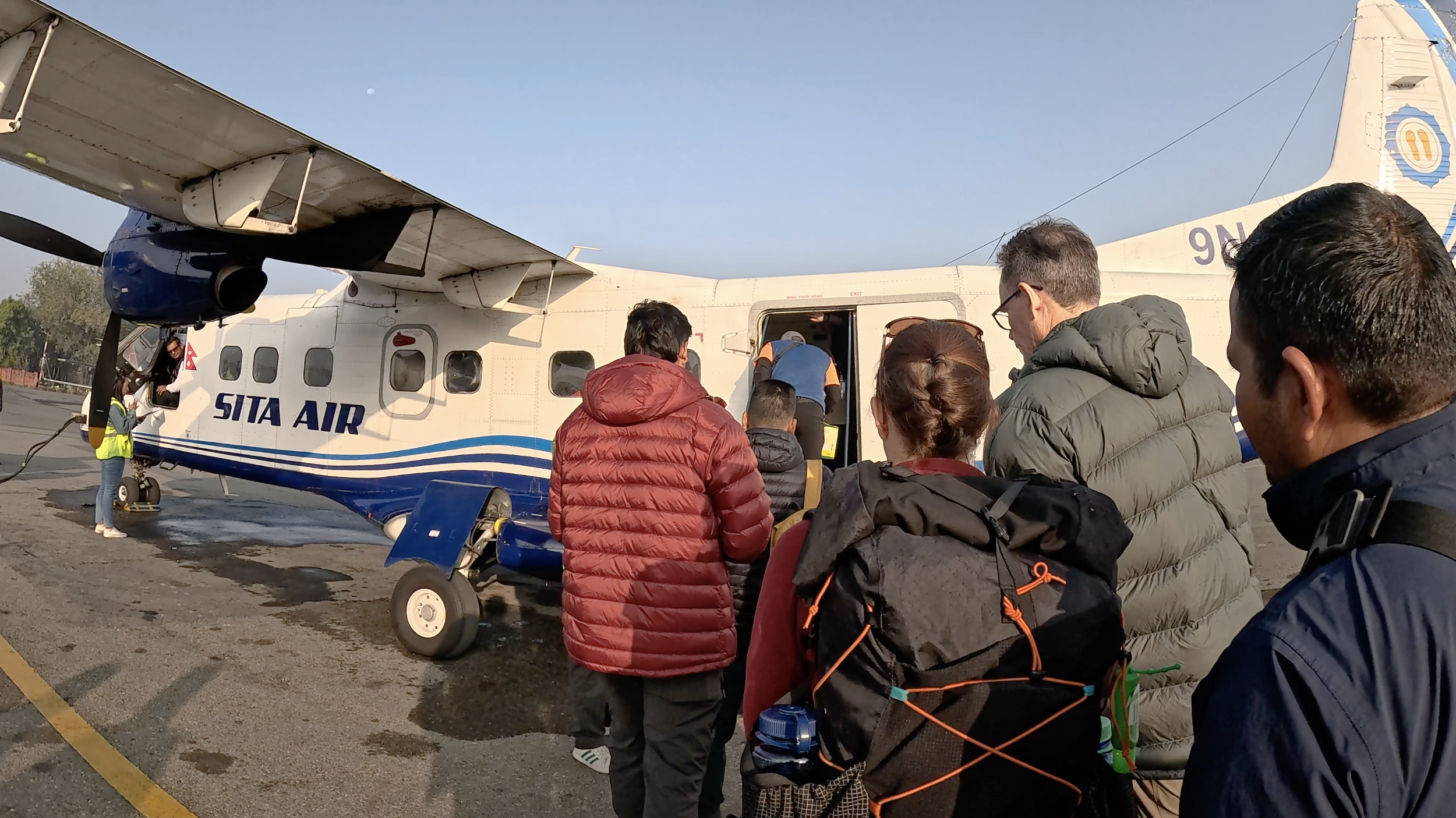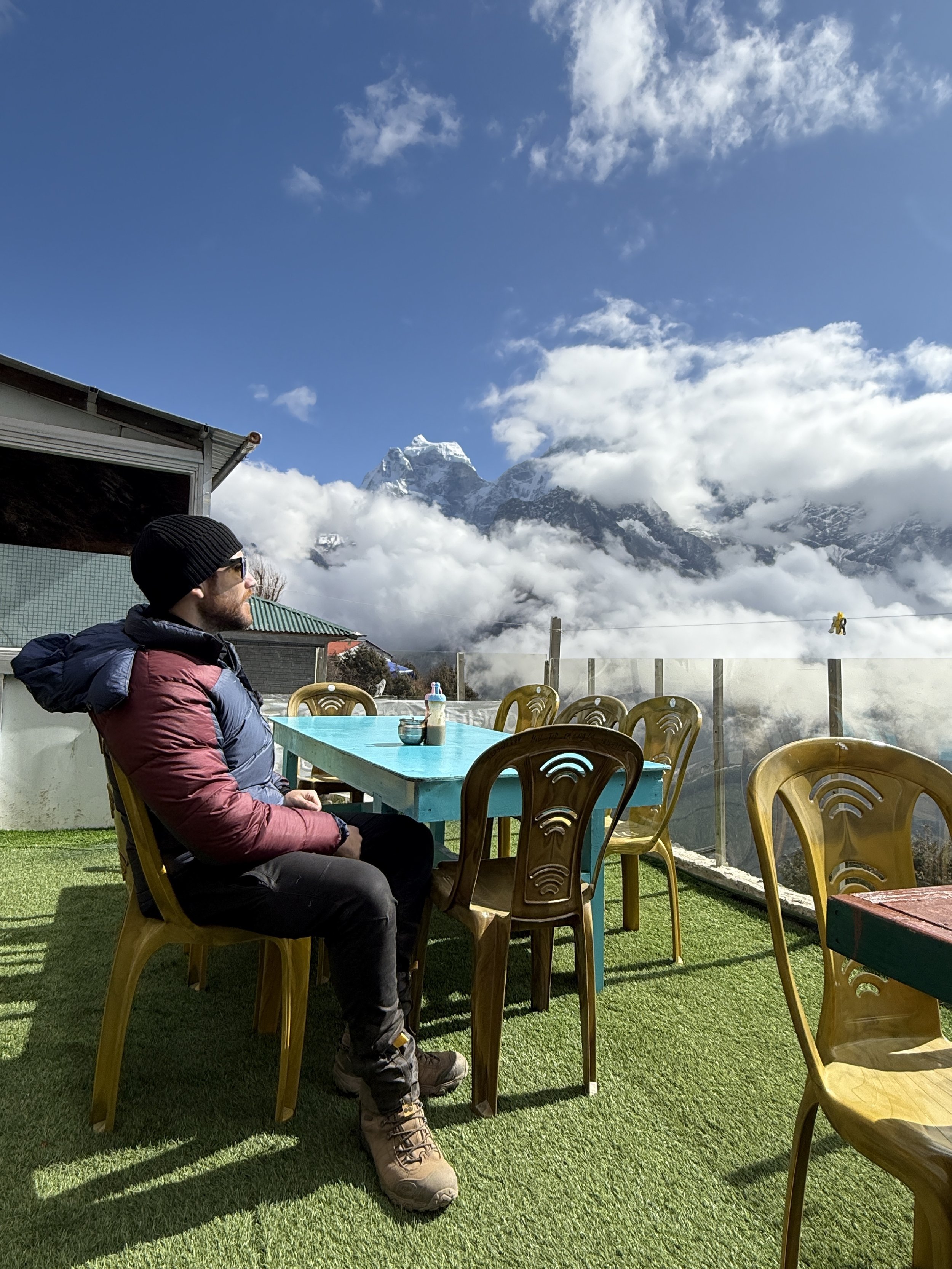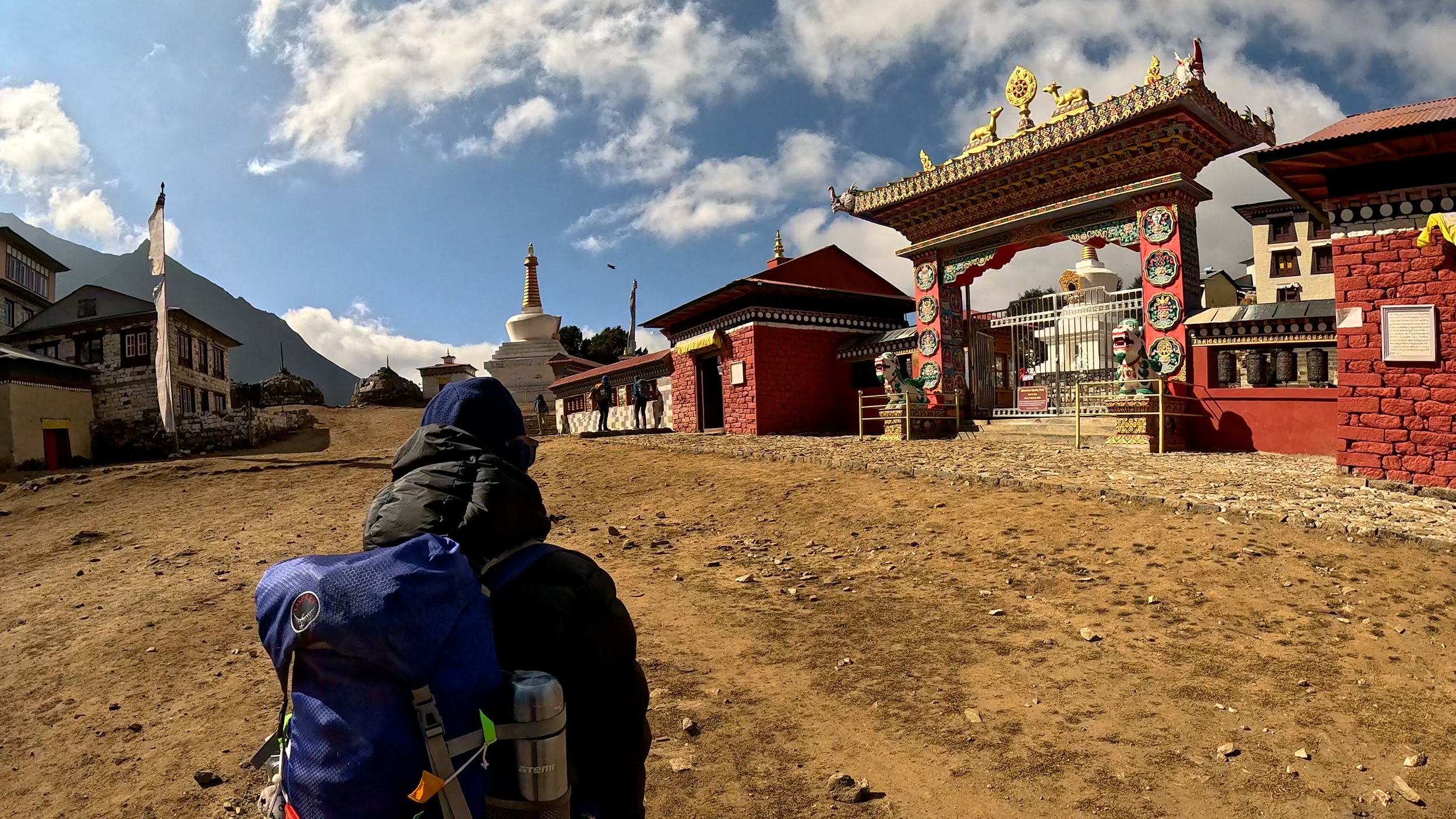Everest Base Camp Trek Itinerary
Arrival and Kathmandu (Day 1 & Day 2)
Day one of your Everest Base Camp journey starts the moment you land in Kathmandu — Nepal’s chaotic, colorful, and wildly captivating capital. After you clear customs at Tribhuvan International Airport, your trekking company should be waiting to pick you up. If you're going solo, no worries — just brace yourself for the semi-organized chaos outside the airport gates. It’s all part of the adventure.
Arrival in Kathmandu, nepal
I highly recommend staying in the Thamel neighborhood. It’s where all the action is — restaurants, bars, cafés, and last-minute trekking shops. Whether you forgot water purification tablets or realize your socks aren’t warm enough, you’ll find what you need here. And yes, they rent gear too — sleeping bags, poles, you name it.
Day two is more than just downtime. You’ll likely meet your guide, get a gear check, and go on a city tour that includes famous sites like Swayambhunath (Monkey Temple), Boudhanath Stupa, and the sacred cremation grounds at Pashupatinath Temple. It’s a surreal cultural immersion that gets you mentally prepped for the spiritual part of the trek ahead.
Buffer tip:
You don’t need to arrive in Nepal days in advance — one buffer day before your Lukla flight is enough. But for your return trip? Build in two full days in Kathmandu. Lukla flights are weather-dependent and often delayed. The last thing you want is to miss your international flight because of cloud cover in the Himalayas.
Your Everest journey begins here — Thamel, Kathmandu’s backpacker hub.
Flying to Lukla and Starting the Trek (Day 3)
Now things get real. You wake up before sunrise to catch your flight to Lukla — a 30-minute ride that will make every other flight in your life feel boring. The Tenzing-Hillary Airport is carved into a Himalayan cliff and is regularly listed as one of the most dangerous airports in the world. And when your tiny plane banks between snow-capped peaks to touch down on a steep, short runway? Yeah, you’ll believe it.
Once you land, it’s go time. Your porters get organized, your gear gets strapped up, and the trek officially begins. Day three’s walk is fairly mellow — a downhill stroll to Phakding that takes a few hours. You’ll pass Buddhist prayer wheels, mani stones carved with Sanskrit mantras, and your first suspension bridges — all against a backdrop of pine forest and mountain mist.
Pro tip: Don’t rush. This part is about easing into the trek. You’ll feel strong and tempted to go fast, but resist it. Acclimatization is about gradual exposure to elevation. Take your time, soak it in, and let your body adjust.
Flight to Lukla
Day 4: Phakding to Namche Bazaar
This is one of the most important days of your entire Everest Base Camp trek. You’ll wake up in Phakding, a peaceful village nestled along the Dudh Koshi River, and begin your first serious uphill climb toward Namche Bazaar — the gateway to the Khumbu region. The trail today is challenging, scenic, and unforgettable. You’ll cross multiple suspension bridges, pass through tiny mountain villages, and walk under colorful prayer flags fluttering in the wind. The most iconic moment of the day? Crossing the Hillary Suspension Bridge — a steel, prayer-flag-covered span that swings hundreds of feet above the river below. It’s thrilling and slightly nerve-wracking, but completely safe.
As you climb higher, the forest thins out and you’ll start to feel the altitude. The air gets thinner. Your breathing gets heavier. And your legs? They’ll start burning on the relentless switchbacks leading into Namche. But if the skies are clear, you’ll be rewarded with your very first glimpse of Mount Everest — a tiny triangle far in the distance, peeking between massive ridgelines. It’s humbling and exhilarating all at once. When you finally reach Namche Bazaar, the payoff is huge. Built into a natural amphitheater of stone and pine, Namche is a stunning alpine village buzzing with trekkers, cafes, bakeries, and gear shops. You’ll feel the energy here — a mix of nerves, excitement, and relief. You made it to the biggest village on the trail. And trust me: it feels like a milestone.
Standing on the Hillary Suspension Bridge — a dramatic highlight on the trail to Namche Bazaar.
Day 5: Acclimatization Day in Namche Bazaar
After the tough ascent from Phakding to Namche, your body will be craving a break — but don’t expect a lazy day. Day 5 is your first acclimatization day, which means staying at the same elevation overnight to let your body adjust to the altitude. But to do that properly, you actually have to hike higher during the day and then return to Namche to sleep. The most popular option? A scenic hike to the Everest View Hotel — one of the highest-altitude hotels in the world. The trail is steep, but it rewards you with panoramic views of Ama Dablam, Lhotse, and Everest herself in the distance. It’s one of the best spots on the entire trek to see the mountain in full daylight.
After your hike, the rest of the day is yours to explore Namche. Walk the narrow stone alleys, visit the local Sherpa museum, and grab a cappuccino at one of the shockingly good bakeries (yes, bakeries!). If you forgot any gear or want to stock up on snacks, this is the place to do it. Namche is your last major outpost before the real high-altitude wilderness begins. Acclimatization days like this are essential — even if you feel great. The extra time helps your body produce more red blood cells and makes the rest of the trek far safer and more enjoyable. So don’t skip it, and don’t underestimate how much your body is working, even if your legs aren’t climbing all day.
Everest in the distance — captured from the Everest View Hotel trail during our acclimatization hike.
Namche to Phortse – Taking the Less Crowded Route (Day 6)
Most trekkers follow the classic trail from Namche to Tengboche, but I wanted something quieter and more scenic — so I took the less-traveled route to Phortse. It’s a game-changer. This trail winds along stunning ridgelines with jaw-dropping views of Ama Dablam and other Himalayan giants. One of the best parts of this alternate path is Mong-La, a tiny teahouse village perched dramatically on a ridge. It’s one of the most beautiful spots on the entire trek, and a great place to rest and soak in the surroundings. From there, the trail narrows and gets more rugged, winding down and up again toward Phortse, a peaceful and remote village that sees far fewer tourists than the main route. It felt like stepping into another world — quiet, spiritual, and totally surrounded by wild nature. If you want solitude and incredible scenery, this day delivers.
The lesser-traveled ridge route to Phortse offers nonstop views like this.
Phortse to Dingboche (Day 7)
Leaving Phortse, the trail climbs along another stunning stretch of exposed hillside. You'll be hiking above the tree line now, with wide open views of Ama Dablam stealing the show for most of the day. This mountain becomes your constant companion, and honestly, it might be the most photogenic peak of the whole trek. The trail snakes through small settlements like Pangboche and Somare, where you can grab a hearty lunch and rest up before the final push to Dingboche. As you gain elevation, the villages feel more remote and wind-swept, with fewer people and more rugged terrain. Dingboche itself is one of the larger stops on the trek, nestled in a high-altitude valley surrounded by towering peaks. It’s a great place to recharge, do some laundry, and mentally prepare for the challenges ahead. The air is thinner here, so take it slow and listen to your body.
(Optional) Acclimatization Day in Dingboche (Day 8)
This is where your trek itinerary might differ from mine. Most people take an acclimatization day in Dingboche — usually hiking up to Nagarjun Hill to help their body adjust to the altitude. I decided to skip it. In hindsight, I’m still not sure if that was the right move. On one hand, I felt strong and wanted to keep moving. On the other, I ended up getting altitude sickness later on — and maybe this skipped day was the reason. If you’re not 100% confident in how your body’s reacting, I strongly suggest taking the rest day and doing the day hike. Nagarjun Hill gives you panoramic views and helps your body prep for the even thinner air ahead. Rest, hydrate, eat, and listen to your body. No ego here — you’ll thank yourself later.
Dingboche to Lobuche (Day 9)
Lobuche
By the time you leave Dingboche, you’re deep into high-altitude territory — and you’ll feel it. The trail begins with a slow but steady climb as you start to notice the landscape shift dramatically. Trees disappear. The air feels drier. Every breath takes more effort, and every step starts to feel heavier. But there’s something humbling about this part of the trek. You pass through the wide, windswept valley of Dughla before ascending to a heartbreaking stretch: the memorial area for climbers who died on Everest. Stacks of stones, prayer flags, and engraved plaques honor those who never made it back. It’s one of the most emotional moments of the journey — a place where the reality of Everest hits you hard. After spending time reflecting here, you push onward to Lobuche, a small outpost that feels more like a survival base than a village. At this altitude, don’t be surprised if you lose your appetite or start feeling the effects of thinner air. Rest well. Tomorrow is the big one.
Everest Base Camp Day (Day 10)
Touching the top of the world—Everest Base Camp.
This is the day everything’s been leading up to — Everest Base Camp. You start early, trekking from Lobuche to Gorak Shep, which is the last bit of civilization before Base Camp. The terrain is tough: rocky, uneven, and full of elevation gains that punch you in the lungs. Once you drop your bag in Gorak Shep and grab a quick bite, you hit the trail again — now lighter, but also more exhausted. The path to Base Camp is surreal. You’re winding through a landscape of moraine ridges, glacial debris, and towering white peaks. Then, finally, you see it: the prayer flags, the boulder with “Everest Base Camp” scrawled across it, and the legendary Khumbu Icefall shimmering in the distance. It’s not the highest point of the trek — but emotionally, it’s the summit. You don’t sleep here (too risky), so after soaking in the moment, snapping your photos, and catching your breath, you head back to Gorak Shep for the night. Trust me — you’ll sleep like a rock.
Kala Patthar Sunrise and Descent to Pheriche (Day 11)
Kala Patthar
Just when you think you’ve hit your emotional high point, Kala Patthar takes it one step further — literally. You wake up before dawn, bundle up in all your layers, and begin the steep climb. It’s only about 2-3 hours, but it feels like a full day. Your reward? The absolute best view of Mount Everest you can get without a climbing permit. At sunrise, the golden light hits the summit in a way that stops time. You’ll forget how cold and tired you are. After taking it all in, you descend quickly back to Gorak Shep, grab breakfast, then continue the long trek down to Pheriche. The descent feels like exhaling. You’re dropping altitude, gaining oxygen, and your energy starts to return — but your legs will still be toast by the end of the day.
Pheriche to Namche Bazaar (Day 12)
Return Descent Through Tengboche Monastery
This is one of the longest descent days on the trek. You leave Pheriche and hike back through familiar villages — Pangboche, Tengboche, and eventually back to Namche Bazaar. You’ll notice how much more oxygen is in the air as you descend, and your legs will appreciate the richer atmosphere, even if they’re tired. Don’t let your guard down, though — the trail is still steep and rocky, and your legs are more likely to make mistakes when fatigued. When you finally arrive in Namche, it feels like a return to civilization. Shops, bakeries, and hot showers are all waiting for you. You’ve completed the most intense part of the journey, and it’s time to celebrate a little.
Namche Bazaar to Lukla (Day 13)
Don’t underestimate this final trail day. From Namche to Lukla is long — very long — and your knees will feel it. The trail is steep, full of loose stones, steps, and bridges. You’ll pass through many small villages, saying goodbye to the mountains and the people you’ve met along the way. It’s a full-circle moment. Once you reach Lukla, it’s time for celebration. Most trekkers toast the end of the trail with a cold Everest beer or a round of dal bhat. You’ll feel proud, sore, emotional, and maybe even a little sad that it’s over. But you did it. You made it to Everest Base Camp and back.
Lukla
Flight Back to Kathmandu (Day 14)
Assuming the weather cooperates, you’ll catch your flight from Lukla back to Kathmandu. This short flight is always a bit of a gamble — delays are common due to fog or wind. That’s why I recommend building in at least two buffer days in Kathmandu before your international flight home. Once back in Kathmandu, you’ll feel the contrast of noise, heat, and crowds — a far cry from the silent peaks of the Khumbu. Spend those buffer days eating amazing food, shopping in Thamel, or visiting temples you missed at the beginning of the trip. You’ve earned the rest.
Breathe a sigh of relief — flying out of Lukla means you’ve officially completed the trek.
Final Thoughts: Watch the Full Trek on YouTube
If you’d rather see this itinerary brought to life — complete with breathtaking views, drone shots, and real trail footage — I’ve got you covered. I turned this entire itinerary into a YouTube video where I walk through every day of the trek, sharing visuals, pacing tips, and honest insights along the way.
👉 Watch the Everest Base Camp Itinerary Video on YouTube
It’s the next best thing to being on the trail yourself.
🌍 Want the Full Everest Experience?
This post is just one part of a full Everest Base Camp video series I filmed while trekking through the Himalayas. From the moment I landed in Kathmandu to my final step back in Lukla, I documented everything — the altitude, the struggle, the views, the people, and the reality of what it’s like to hike one of the world’s most iconic trails.
👉 Binge the Full Everest Base Camp Trek Series on YouTube
Whether you’re planning your own adventure or just curious what it’s really like, this series will take you there.
Subscribe, follow along, and get inspired to travel far.














